Little about Andrea Zittel’s latest body of work evokes conventional furniture. On the contrary, the nine imposing metal Planar Configurations that form the core of the artist’s recent show at Regen Projects call to mind an assortment of the last century’s sculptural and painterly forays into geometric abstraction. The amber-accented Planar Configuration Four (2017), for example, hardly screams “bed.” No more does the cobalt interior of Planar Configuration Two (2017) resemble a chaise lounge. But we are nevertheless helped to such conclusions by the presence of props in and on the otherwise abstract sculptures: a simple mattress smartly made up with pillow and linens, a cushion with a stack of folded newspapers, a woven textile positioned like a welcome mat. These are useful things, we surmise. Useable, anyway.
The Planar Configurations share a palette of black, white, and gray, with muted versions of the primary colors helping to visually differentiate the three compositional types on view. They sport sleek powder-coated finishes, which, like their thick steel frames and aluminum cladding, speak of vaguely industrial origins. Apparently held together by regularly spaced hex socket bolts, which are visible at their joints, the fabricated structures also seem as if they could be assembled by hand with the help of little more than an Allen wrench and a capable friend. Indeed, styled with plush accessories and arranged in attractive rows, the Configurations all but transform Regen Projects into an austere, deserted, and utterly alien IKEA-like emporium showcasing futuristic wares scaled for beings of our proportions. And yet, despite their utilitarian overtures, the Configurations also retain their privileged status as art. After all, Zittel’s show sustains the usual gallery decorum, which means that any touching of the works is strictly forbidden. Cushions or no, if these abstractions have any use-value, it is destined to be provisional and speculative—at least for those of us not looking to buy.
It is here that Zittel’s work unfolds—between the categories of sculpture and furniture, between abstract form and everyday utility. The Planar Configurations persist simultaneously in two incompatible states, with Zittel’s homey props and textiles operating like fulcrums facilitating each sculpture’s categorical shift into furniture and back again. And so, confronted by each Configuration as if by an inscrutable but tantalizing window display, we imagine: what would it be like to sleep on the artwork, to nestle into its sterile confines, to read about the day’s relentlessly bleak news from within its cool shell? What would it be like to live in or with or upon these sculptures, to be at home on these planes?

Andrea Zittel, installation view, Regen Projects, Los Angeles June 8–August 12, 2017. Courtesy of Regen Projects, Los Angeles. Photo: Brian Forrest.
Some fifty years ago, a version of this art-furniture problematic played itself out as artists associated with minimalism found themselves in surprising proximity to the world of everyday things. By 1967, art critic Michael Fried understood that the uninflected minimalist box and its non-compositional seriality posed a serious threat to the category of art.1 He famously excoriated the work of artists such as Donald Judd and Robert Morris for its theatricality: in refusing pictorial composition, in refusing the meaningful relation of parts into a grammatically coherent whole, Fried argued that minimalist art became irrevocably literal and object-like. Minimalism also worried Clement Greenberg, who could only see it as fashionable boundary-pushing, as a pursuit of the “far-out” and “shocking” look of non-art for its own sake.2 More damning still, Greenberg likened minimalism to Good Design, referring to the Museum of Modern Art’s 1950s initiative to shape modern taste and promote its vision of modern living by exhibiting and merchandizing exemplars of midcentury design. For art to capitulate to the commodity form, Greenberg thought, meant a forfeiture of its autonomy, of the very separateness from mass culture on which its criticality was staked.3 When he then argued, “Minimal works are readable as art, as almost anything is today—including a door, a table, or a blank sheet of paper,”4 he registered not only their ostensible status as non-art but also their perilous closeness to the sleek and functional kitsch barbarously pushed by MoMA.
Whether or not we share in such paranoia, it would be difficult to argue that Greenberg’s and Fried’s fears were wholly unfounded, for it would not be long before Judd himself was making objects—chairs and tables, beds and shelves. He dabbled in such pursuits in his New York City loft in the 1960s. Upon relocating to Marfa, Texas, in the early 1970s, his DIY production of furniture increased, as he built a fully customized domestic world. And by the 1980s, he was overseeing the fabrication of metal furniture explicitly to be sold. Judd would always maintain that the two pursuits, art and furniture, had absolutely nothing to do with one another, that they could not be further apart, as if he understood the stakes all too well. “The furniture is furniture and is only art in that architecture, ceramics, textiles and many things are art,” he argued. “We try to keep the furniture out of art galleries to avoid this confusion, which is far from my thinking.”5 Nevertheless Judd’s furniture did look uncannily like his sculpture: industrial, boxy, simple and pared down, geometrically precise, even proliferating in various permutations reminiscent of his serialized works.6 And in the end no discursive scaffolding could prevent minimalism’s lapsarian collapse into everyday life and commerce. By the 1990s, Calvin Klein’s flagship New York City store featured shelving and seating designed by Judd, while the boutique Miu Miu invented its own Juddian, sculpture-like units repurposed to display designer clothing.7
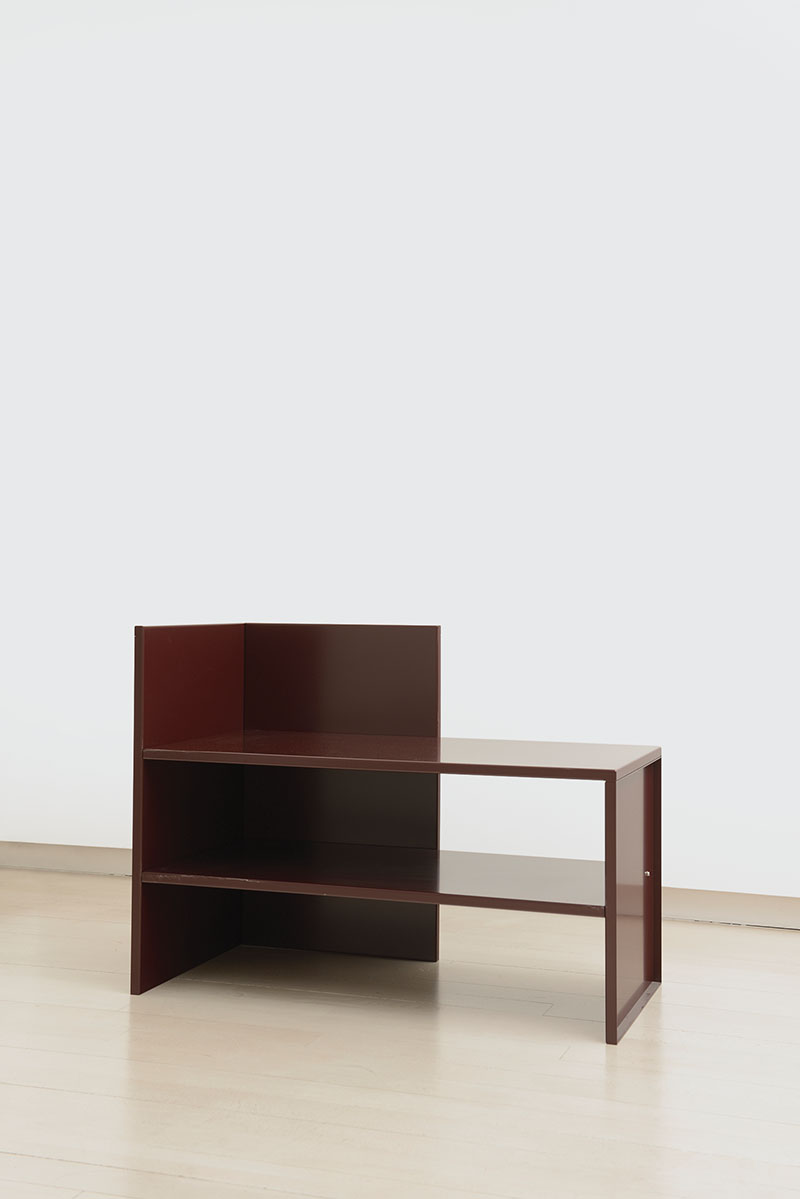
Donald Judd, Corner Bench 6, designed in 1984. Painted aluminum in Black red/RAL 3007, 29 1⁄2 x 39 3⁄8 x 19 3⁄4 in. Donald Judd Furniture © Judd Foundation. Courtesy Galería Elvira González. Photo: Cuauhtli Gutiérrez.
If Judd labored to preserve the boundary between art and non-art, if he made certain never to “confuse” his furniture with his sculpture, in Zittel’s Planar Configurations, such confusion is all we get. Short of full-blown minimalism, the artist revives elements of its formal, procedural, and material logic—its industrial components, its machined impersonality, its glossy finish, all installed, as Judd might have said, “one thing after another”8—in order to deliver sculpture that is also furniture, sculpture that explores the ramifications of minimalist objecthood in giving itself over to use. The two woven Parallel Planar Panels (2017), also installed in the main gallery, operate with a similar categorical indeterminacy: one hangs on the wall like a tapestry, its abstract design offering the Planar Configurations a matching ornamental accessory, if in the diverging aesthetic of pre-industrial handi-craft; the other juts perpendicularly into the space, where it materializes as a fibrous, room-dividing partition. Judd once claimed that minimalist work was “neither painting nor sculpture,” but still it remained art.9 Here that logic is extended: neither painting nor sculpture nor ornament nor furniture nor architecture, and so on. And in really being none of these things at all, the Planar Configurations become in potentia all of them simultaneously.
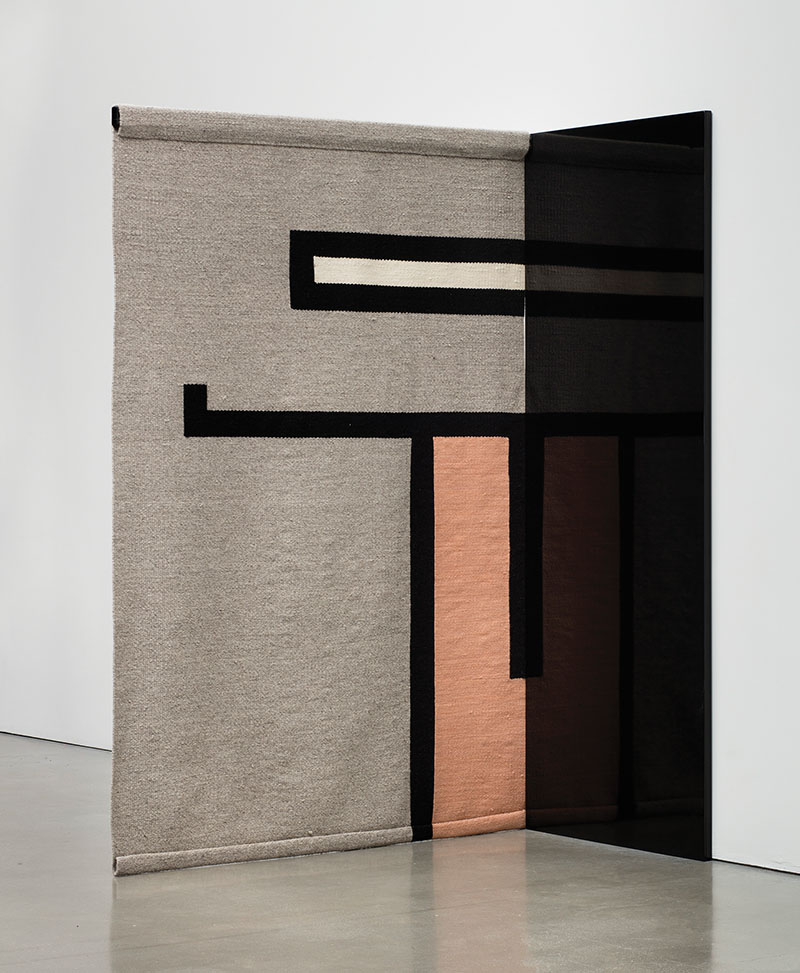
Andrea Zittel, Parallel Planar Panel #3 (grey, black, off-white, pink), 2017. Powder-coated aluminum and steel and woven wool textile, 94 1⁄8 x 59 1⁄2 x 33 1⁄4 in. © Andrea Zittel. Courtesy of Regen Projects, Los Angeles.
Such constitutes the distinct openness of Zittel’s Configurations, their excess and perpetual incompletion in the face of a beholder positioned not only as a potential consumer but also as an agent in deciding their categorical fate. Indeed, perhaps these positions are not so far apart in Zittel’s thinking. “Authorship starts with the person who designs it,” she has explained, “but then the owner or user creates another layer of authorship.”10 Sure enough, catalogs of her work portray it in both the white-walled environs of the gallery and in the less pristine domestic interiors where it accumulates these additional layers of authorship. Reproduced in both locales, we also find Zittel’s work regularly supplemented by the human figure—not in the conventional guise of contemplative beholder but instead (and not entirely unlike IKEA catalogs, perhaps) as surrogate owner and user. Zittel’s Carpet Furniture works of the early 1990s exemplify this shift: at first resembling decorative rugs, the addition of human proxies—who dine from table-sized squares or snooze on bed-sized rectangles—instructs us that their abstract designs can and should be used. Needless to say, precious few will have the opportunity to actually engage Zittel’s work in this way, to co-or re-author it. The Planar Configurations at Regen Projects may beckon, but they remain undeniably art-like in their scarcity, their price tag, their retreat from human contact. Still, to the extent that we long for them or even sustain a passing curiosity about them, the Configurations undergo a transformative declension by way of their props. Like relics of previous users or enticing lures for future ones, these props encourage us to experience the Planar Configurations in the subjunctive mood—what life with one might be like. Or as Zittel herself has put it, “I like cooking up scenarios for ways the world could exist.”11
—
In its forward-looking optimism and the expansiveness of its yearning, Zittel’s turn of phrase—“ways the world could exist”—has the unmistakable ring of utopianism. First coined in Sir Thomas More’s 1516 book of the same name, Utopia identified a fictional island whose rational governance and humanist values posited an egalitarian social alternative to the author’s native England. It was an ideal place (or so at first it seemed) that was also physically inaccessible, subsisting ultimately in the realm of thought and discourse. More’s very neologism captured this tension lexically: its prefix u-deriving from both the Greek eu (good) and ou (not), Utopia was a “good place” that was also “no place” at all.12 Insofar as utopia designates such an impossible wish-place borne of the real but transcendent of it, a future not-yet and never-to-be realized, the term anticipates our own frustrated terms of engagement with Zittel’s works at Regen Projects. The Configurations may envision use-value, but they never really expend it.
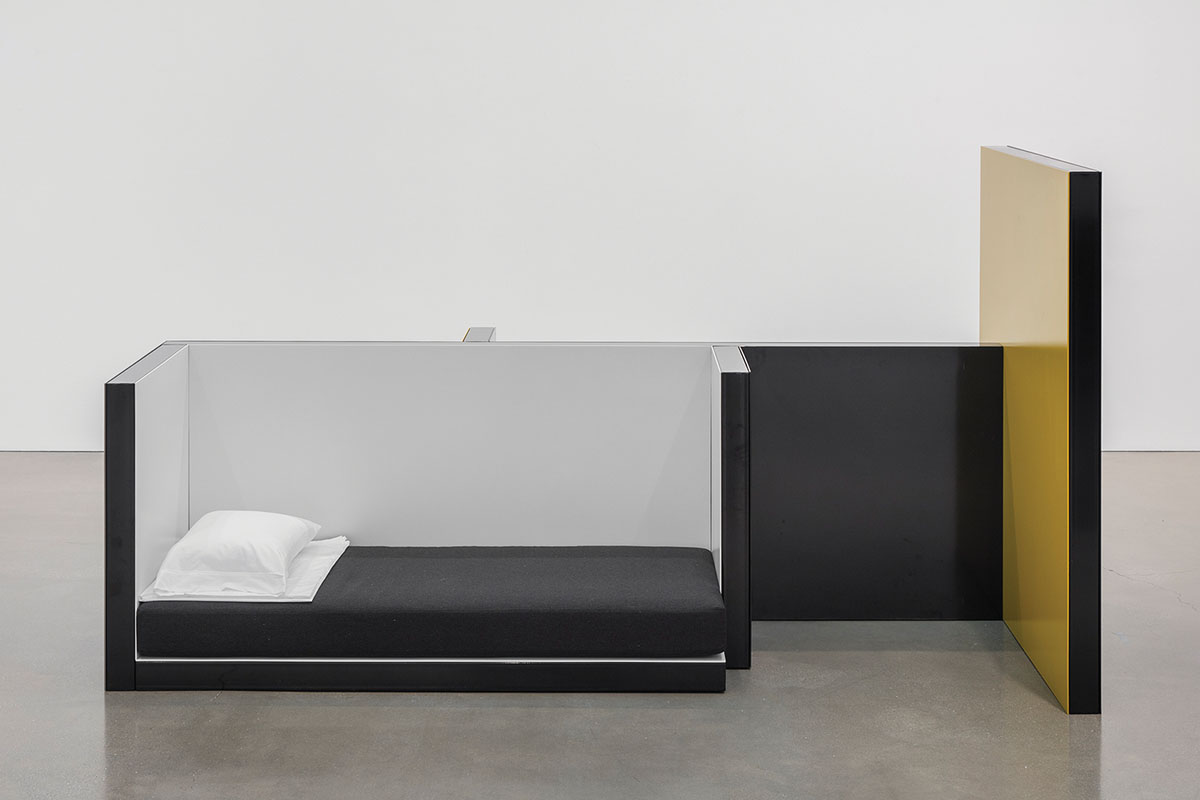
Andrea Zittel, Planar Configuration Four [#1], 2017. Powder-coated steel and aluminum, cushion, blanket, pillow, 71 5⁄8 x 66 1/34 in. © Andrea Zittel. Courtesy of Regen Projects, Los Angeles.
Those familiar with Zittel’s practice might shudder at my invocation of utopia, might find it something of a cruel joke in the context of a body of work that, for some, verges on the tyrannical and sadistic: a piece of fold-out furniture that consolidates the body’s input and output functions, to put it politely, into a single columnar device (A-Z Body Processing Unit, 1993); the prescribed use of minimal chamber pots for a year (A-Z Chamber Pots, 1993); the reduction of an entire wardrobe to a single garment to be worn daily (A-Z Uniforms, an ongoing project initiated in 1991). Yet remarkably, at stake in such works is freedom, for the crucial gambit in Zittel’s binding of daily routine by strict rules or perverse devices is that simplicity and austerity, voluntarily adopted, can be personally liberating. “What makes us feel liberated is not total freedom,” she has written, “but rather living in a set of limitations that we have created and prescribed for ourselves.”13 Of A-Z Uniforms, for instance, Zittel explained, “Having a uniform would be much more liberating than having constant variety,”14 a sentiment with which anyone who has ever panicked about what to wear will readily identify. Surely the wares on view at Regen Projects elicit a similar ambivalence. Are they inviting cubbies that facilitate naps and reading, loafing and leisure? Or unforgiving and confining cubicles breeding anti-sociality? The very same ambivalence underpins More’s imagined social alternative, too, whose enlightened populace tolerates some rather draconian policies indeed.15 Zittel’s Configurations may thus envision new and even alluring ways that our domestic world could exist, but, particularly given their uncompromising size and immobility, at what cost to our existing values, habits, and routines, to say nothing of our furnishings?
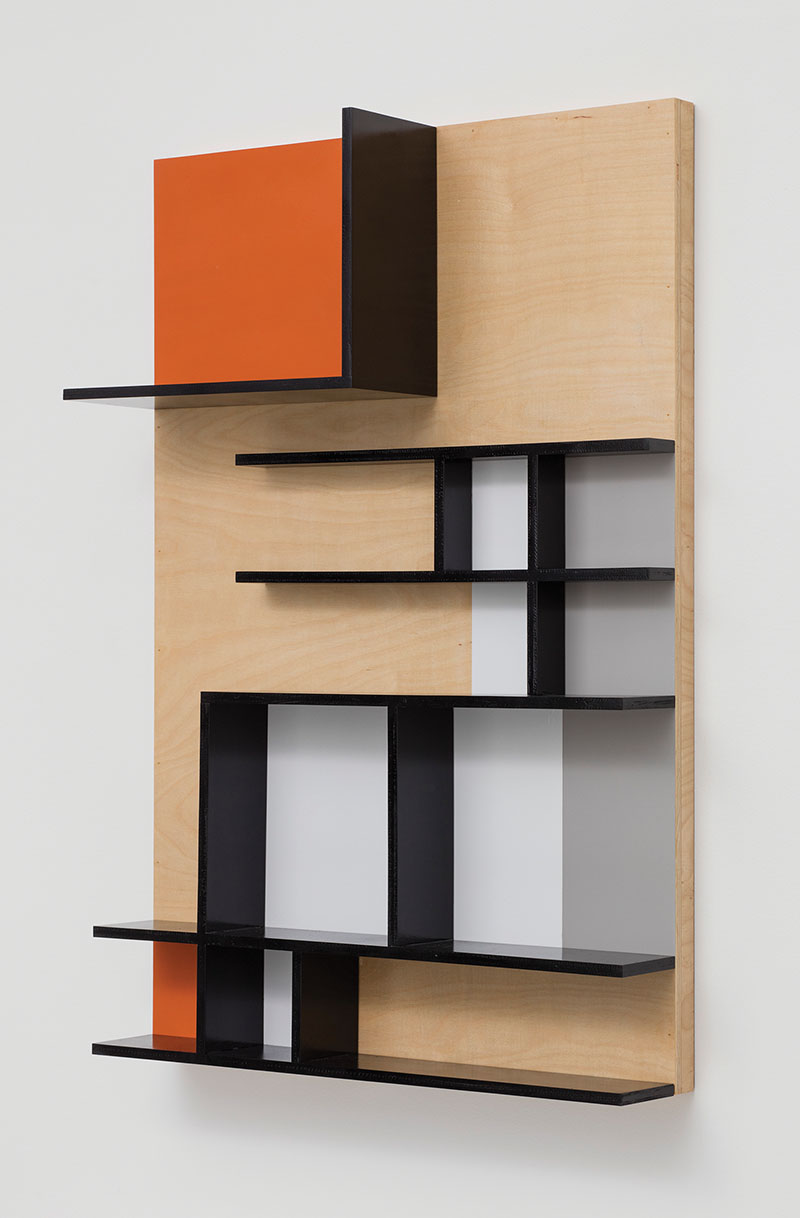
Andrea Zittel, Study for Planar Configuration #5, 2017. Wood and paint, 38 1⁄2 x 26 x 5 1⁄2 in. © Andrea Zittel. Courtesy of Regen Projects, Los Angeles.
Even before encountering the Planar Configurations and the woven Parallel Planar Panels, references to the utopian emerge rather forcefully in a trio of watercolor and gouache works on paper that hang in the gallery’s foyer. Titled Studies for Planar Panels (2017), these works unambiguously invoke Piet Mondrian and others associated with De Stijl in their gridded rectilin-ear compositions, their heavy black horizontals and verticals, their splotchy washes of off-white, gray, and time-worn red, yellow, and blue—“colour,” Mondrian once said, “in its most basic aspect.”16
Mondrian’s aesthetic system, Neoplasticism, evolved out of an imperative to express the universal, to touch in pure and abstract terms nothing short of the absolute, as if he could distill the visible world to its irreducible, atomic components: horizontals and verticals, lines and planes, primary colors. He said that Neoplasticism was “the manifestation of the purely aesthetic idea”; it was “cosmic harmony”; it was “the style of the future.”17
And it wouldn’t end with painting, either: characteristic of his utopianism, Mondrian aspired for Neoplasticism’s revelation of the universal to one day be integrated fully into life, as if it could remake a world devastated by the First World War according to principles that could truly be said to be international. Like a model or a roadmap leading to a world to come, Neoplasticism, Mondrian claimed, “shows clearly the universally valid laws on which the new reality is to be built.”18 Of course, this internationalist utopia never came about. But we do have a sense of how such a synthesis of art and life would have looked: Gerrit Rietveld’s Red-Blue Chair (1918) and his Schröder House (1924), the redesign of Café Aubette (1926–28) overseen by Theo van Doesburg, even Mondrian’s Paris atelier of the late 1920s. Compositionally dynamic and holistic, as if the color and two-dimensional planarity belonging to painting were suddenly concretized as walls and partitions, such projects are in retrospect strikingly conventional, too, at least in terms of how they imagined function. Amidst the excessive Neoplastic adornment engulfing his studio, for example, Mondrian still sat in an ordinary wicker chair, worked at an ordinary desk, and slept in an ordinary bed.19
Next to the Planar Configurations, however, Zittel’s Studies for Planar Panels also look like floor plans—as if the Planar Configurations could have been conjured directly from their Neoplastic geometries; as if Zittel’s showroom-like space, however improbably, might belong to the “new reality” Mondrian awaited. And yet unlike the furniture and environments associated with Neoplasticism and De Stijl, Zittel’s “new reality” is somewhat less straight-forward in terms of how it ought to be used. Judd once wrote tautologically that “a good chair is a good chair.”20 A chair is for sitting, in other words: you know one when you see one. Little wonder that he admired Rietveld’s Red-Blue Chair so much, with its articulated structure and functional clarity.21 But at Regen Projects, a good chair may of course also be a good sculpture, a good bed, a good—well, try it, the work advertises, and find out. This insistence that we try out the work is part of its provocation—even, or perhaps precisely, when we cannot. In the end, I am more interested in how the work reimagines modernism’s utopian strivings than whether it actually accomplishes them.
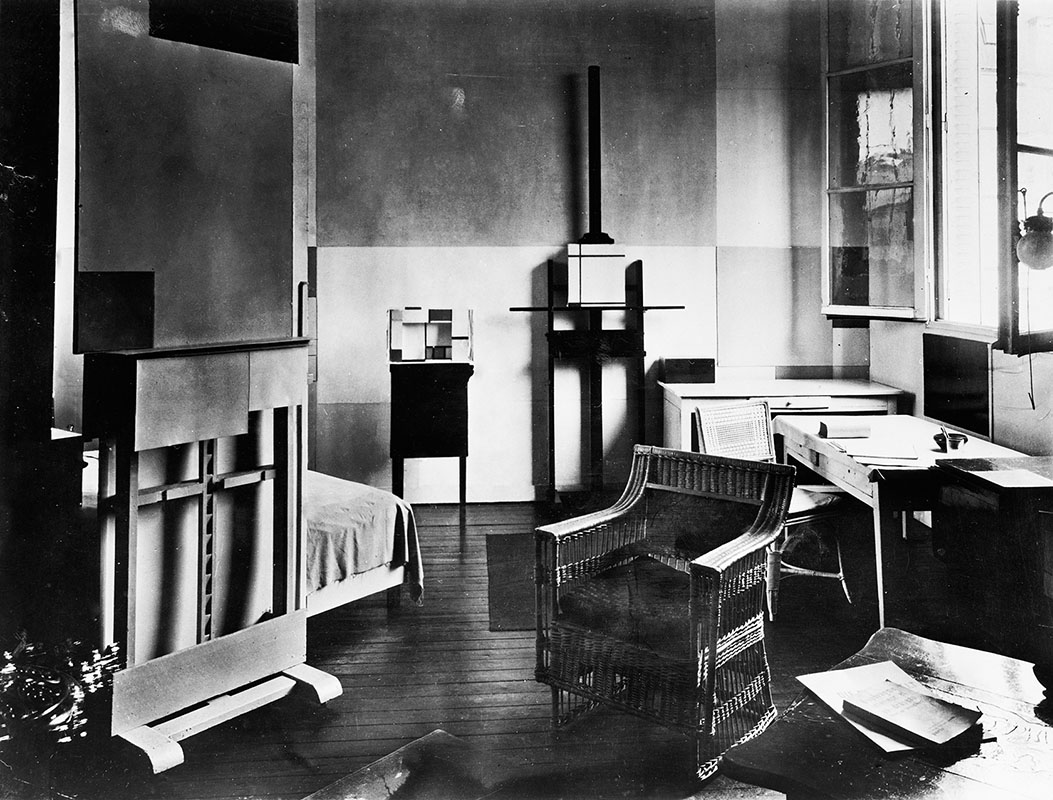
Andre Kertesz, Studio of Piet Mondrian with Composition, 1926. © Estate of Andre Kertesz/Higher Pictures.
—
To the extent that the Configurations’ indeterminate use-value solicits some form of active engagement, be it theoretical or actual, it is telling to discover the specter of El Lissitzky in the show’s final side gallery, a space devoted to schematic works on paper and wooden reliefs that explicitly invoke the procedural and formal language of architecture. These six
Studies for Planar Configurations (2016–17) correlate recognizably with the realized Planar Configurations in the manner we expect of preliminary architectural sketches—elevations, perspective drawings, renderings, and three-dimensional maquettes where spatial ideas are tried out before entering production. Their planes zooming out at us from a white void, the works on paper in particular bring to mind Lissitzky’s Prouns. Similarly schematic, architectural, and exact in rhetoric, the Prouns’ geometric forms are unmoored and dynamic, subsisting pictorially without so much as a vanishing point. Moreover, this room’s palette has been decisively reduced, so that we are largely left with black, red, and white, as if in full compliance with Lissitzky’s call for “colour which is aimed at a direct physiological effect[:] the fullblooded red; the colour of hygiene and space—white; the black that blots out volume.”22
Lissitzky’s agit-language bespeaks the utopian ambitions underlying his project. Deploying axonometric projection, where parallel planes never illusionistically converge as they do in perspective, Lissitzky came to understand his Prouns not as paintings of objects but as objects them-selves, objects that, in the wake of the 1917 Bolshevik Revolution, possessed an expressly social function. “The artist is turning from an imitator into a constructor of the new world of objects,” he wrote. “Proun begins as a level surface, turns into a model of three-dimensional space, and goes on to construct all the objects of everyday life.”23 What was three-dimensional and object-like about the Prouns was their very inscrutability. For in denying a vanishing point, Lissitzky’s axonometry also destroyed illusionistic space and eliminated any sense of the viewer’s stable point of view, replacing it with spatial ambiguity and dynamic planar forms that receded and projected simultaneously, compositions that refused to settle into any single orientation. Such was the crux of Lissitzky’s distinct brand of art-into-life utopianism: the promise that his Prouns would do away with a passive mode of contemplative viewing and activate a beholder now tasked with inspecting them from all sides like a map or diagram.24 This consumer-turned-producer of knowledge, this agent in the work’s very becoming—this was the revolutionary subject of a Socialist future in which Lissitzky saw himself as having a role.
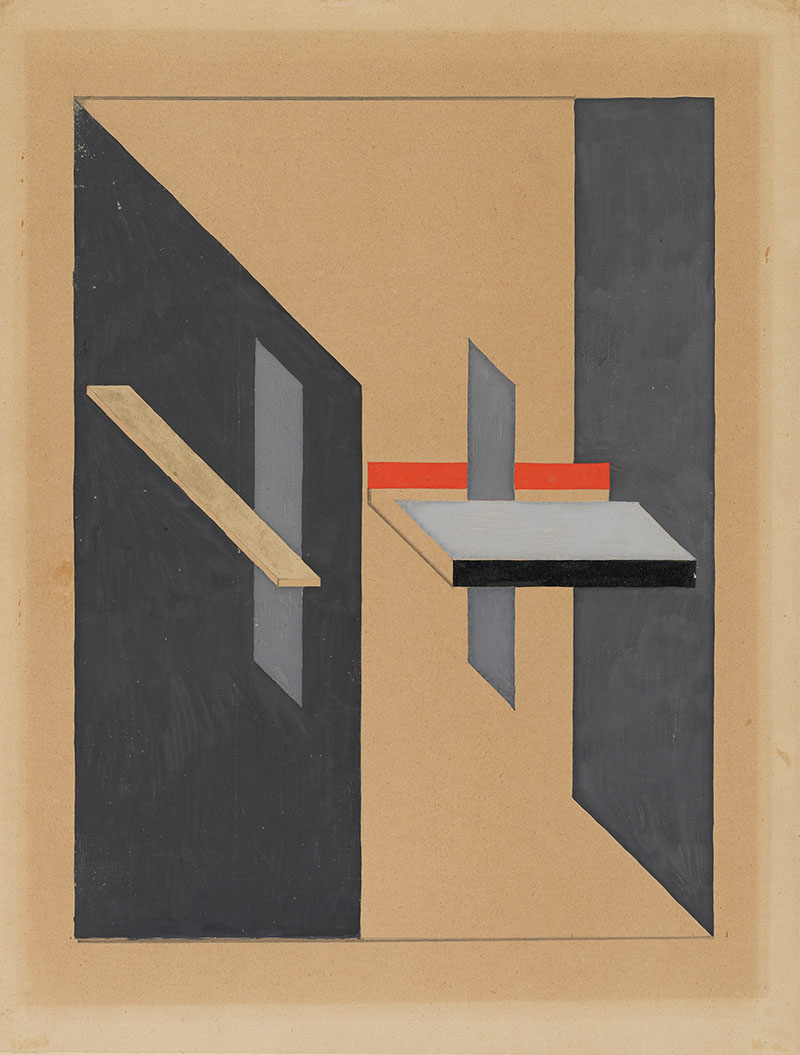
El Lissitzky, Proun, 1923. Gouache, ink, and graphite on tan wove paper, 14 1⁄8 x 10 13⁄16 in. Harvard Art Museums/Busch-Reisinger Museum, The Fredric Wertham Collection, Gift of his wife Hesketh, 1987.61. © Artists Rights Society (ARS), New York / VG Bild-Kunst, Bonn. Photo: Imaging Department © President and Fellows of Harvard College.
Zittel, for her part, relinquishes the axonometric projection. The spaces described in her three watercolor and gouache studies hardly produce the same kind of spatial ambiguity; her zooming planes are grounded (if only just) by a vanishing point. And if architectural models, like maps or diagrams, are ordinarily seen horizontally, encouraging us to approach them from all sides as objects, Zittel has tilted hers up into the vertical axis, as if reasserting the fixed and undeniably pictorial orientation that Lissitzky sought to destroy. By virtue of that verticality, however, Zittel’s wooden models newly erupt into objecthood of another kind, accumulating a new life, possibly as quirky shelving for knick-knacks and tchotchkes.25 And while Zittel’s paper studies anchor their beholder with a vanishing point, the hulking metal Planar Configurations conjured from them float free of functional determination, loosing themselves from the imperative mood that dominates Judd’s or Rietveld’s chairs, objects whose use-value is dictated more than discovered. No ordinary furniture, to live in or with or upon Zittel’s planes is to continually learn how.
—
The kind of art-into-life utopianism I have attributed to Mondrian and Lissitzky has always endeared modernism to Zittel. “It was the last era of great faith,” she has said. “People still really believed.”26 An incurable believer myself, I want to see Zittel as reanimating their hopeful convictions and embracing minimalism’s design-y objecthood, so repressed by Judd and reviled by Fried and Greenberg, as a strategy for reimagining the earlier avant-garde moment. For the early Greenberg, modern art’s increasingly formal concern as it turned in upon itself was what secured its autonomy from hegemonic culture: unlike commercial kitsch, which only served ruling class ideology, avant-garde abstraction, he believed, was critically independent. Zittel returns to exemplars of such autonomous form (recall Mondrian’s pursuit of the universal) but as literal blueprint for an object-world that, once scaled to the human body, emerges as functionally autonomous, too. If ordinary furniture can, like kitsch, be said to reify cultural values as it dumbly services predefined needs and cultural convention, Zittel’s functionally weird Planar Configurations constitute a defamiliarized material culture that stages Lissitzky-like confrontations with its users. And they do this, finally, according to Judd’s unwitting model—art lapsed into the commodity—as if it were not painting or sculpture that might somehow transform life but a category of thing that knowingly appeals to consumer desire, that wants not only to be owned and installed in one’s life but also contended with through use.27
Alas, if Zittel’s commodity-like works are commodities, it is only in the sense that all art objects are: they are not for us, in the end; we will not be the beneficiaries of their activating ambiguity. If anything, the Planar Configurations are closer in status to the prototype, itself a recurring motif in Zittel’s oeuvre. For what is a prototype if not an object instantiated here and now in order to have a future, artisanal and one-of-a-kind in order to be mass-produced, tested privately in order to have a public? Suspended, like More’s Utopia, between our present and an imagined alternative, the work’s use-value remains perpetually deferred, finally belonging to its discursive content more so than its actuality.
Perhaps Zittel is not herself a “believer” then, so much as her work reflects upon utopian strivings of the last century, conceiving an alternative trajectory by which abstract form might have entered life. To that end, the show ultimately strikes a poignant note. The folded, day-old newspapers, the Platonic ordinariness of the beds, the sober cushions—it seems that the only way to exist in this unfamiliar and functionally ambiguous object-world borne directly of abstract form is to force it into recognizability by accessorizing it with the ho-hum accoutrements of a world we already know. Of the attempt to realize utopian dreams, Theodor Adorno once said, “The fulfillment of the wishes takes something away from the substance of the wishes…. One could say in general that the fulfillment of utopia consists largely only in a repetition of the continually same ‘today.’”28 How easy it is indeed for these things to be made familiar once again.
Zach Rottman is a doctoral candidate in art history at the University of California, Los Angeles.
